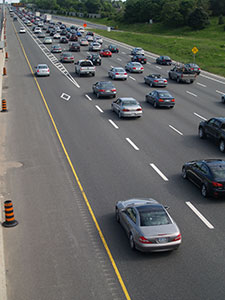
02 Jan Laws on Highway Merging in Texas
What are the laws in regard to merging traffic on Texas highways & freeways? Who has the right of way? Who must yield?
Driving on a highway requires you to be courteous and attentive to other drivers. This is especially true about freeways that have multiple lanes (as well as other motorists looking to merge into a certain lane).
Common sense dictates that if you’re looking to enter highway traffic from an on-ramp, you need to yield to the freeway traffic’s right of way. In fact, certain statutes in Texas law clearly lay this out.
These laws are put in place to help motorists avoid car accidents, but simply having the right of way does not mean that the other driver will be found 100% liable for an accident—you must also drive defensively.
Section 545.061 of the Texas transportation code states that (on a roadway divided into three or more lanes providing for one-way traffic) a driver must yield to traffic on the left when entering a lane from the right. This statute applies to lane changes as well as vehicles entering the roadway.
Some drivers let those entering the freeway have right of way by moving over to another lane so that they can merge safely. Whle drivers on the highway are not required to yield or move over, this is usually done out of courtesy and to avoid an unnecessary collision.
When you’re merging into traffic, you need to pay attention to your speed in order to avoid disrupting traffic. For example, you should enter the freeway ramp and immediately start accelerating so you can match the speed of highway traffic. You should find an acceptable balance where you’re neither going too fast nor too slow to avoid confusing other drivers.
 Section 545.058 of the Texas transportation code goes on to state that the operator of a vehicle may only drive on the shoulder of a road in certain situations, including preparing to merge into traffic. The same driver may also accelerate along the shoulder until a sufficient speed is met to safely merge with highway traffic.
Section 545.058 of the Texas transportation code goes on to state that the operator of a vehicle may only drive on the shoulder of a road in certain situations, including preparing to merge into traffic. The same driver may also accelerate along the shoulder until a sufficient speed is met to safely merge with highway traffic.
If you’re on the frontage lane (service road) of a freeway or expressway, you’re required by law to yield to traffic exiting the freeway or expressway. This is covered under section 545.154. This law covers all entrance and exit ramps, even if there are no yield signs.
Additionally, you’re still required to yield even when the traffic leaving the freeway merges into a separate (dedicated) lane. It’s important to note here that yielding doesn’t necessarily mean stopping, as this may not be safe where there’s fast-moving traffic.
All these statutes exist to ensure your safety, as well as the safety of other drivers on the road. If you’ve been injured in an auto accident while merging (or because of a merging driver), call our car accident lawyers today at 1-877-659-1620.









Sorry, the comment form is closed at this time.